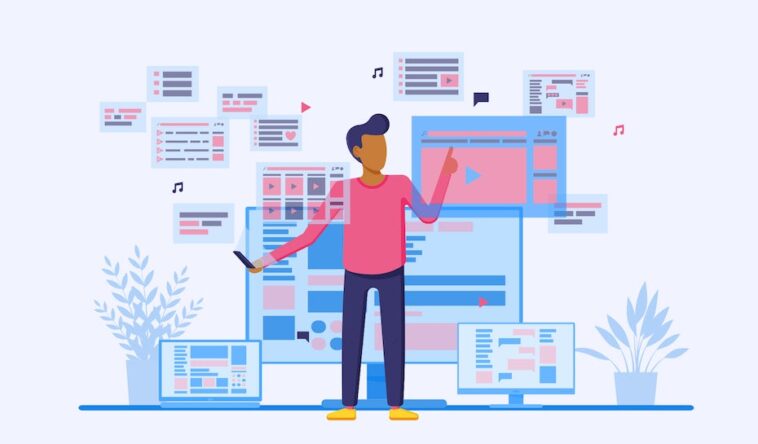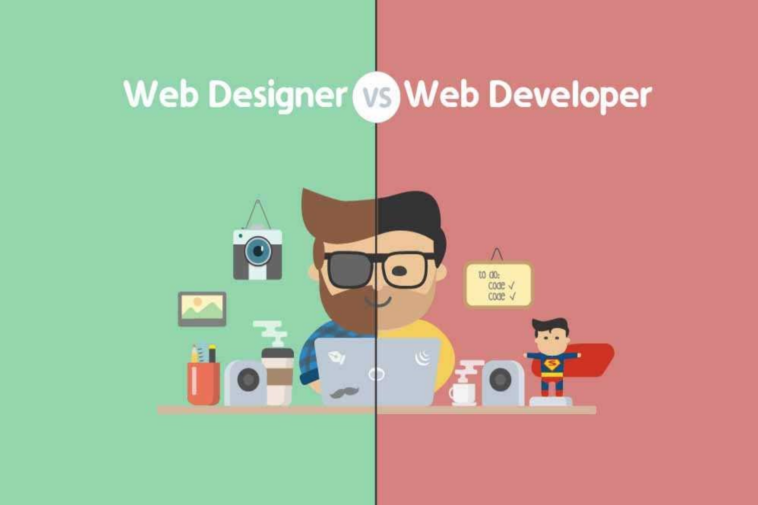How to Distinguish Designers from Developers? The terms ‘web designer’ and ‘web developer’ are mentioned quite often but as often misunderstood. At the core of this confusion lies a question: what is the difference between web design and web development?
This distinction is not just technical jargon but reflects two distinct career paths, each with its unique role, skill set, and impact on the creation of a website.
A web designer, to begin with, is like an architect of the web. They focus on the visual elements and user experience of a website. Their work revolves around creating an engaging, intuitive, and aesthetically pleasing online space.
This involves a keen eye for design, color theory, graphic design, and an understanding of how users interact with websites. Designers use tools and languages more focused on the frontend of a website, such as HTML, CSS, and design software like Adobe Photoshop or Sketch. Their primary concern is how the website looks and feels to the user.
On the flip side, a web developer can be seen as the builder who turns the design into a live, functioning website. They work primarily with coding and programming to develop the backend and the frontend of the website.
Developers deal with the technical aspects of website construction, using languages like JavaScript, Ruby, and Python, and frameworks such as, for instance, React or Angular. Their role is to breathe life into the designer’s vision, focusing on aspects like structure, and performance, and ensuring that all the interactive elements work seamlessly.
Understanding these roles is very important for anyone entering the webpage design services world, whether as a client looking to build a website or an individual considering a career in this field.
Web Designers: UI, UX, and Visual Experts

UI Designers: the Interface Craftsmen
User Interface (UI) designers play the main role in crafting the point of interaction between the user and a digital product. Their focus is on the layout and the elements a user interacts with.
This involves designing buttons, icons, spacing, and typography to create a seamless and intuitive interface. UI designers often use tools like Adobe XD, Sketch, and Figma to bring their visions to life.
Their skill set includes a strong grasp of color schemes, graphic design principles, and responsiveness to ensure that the website not only looks good but also functions well across different devices and screen sizes.
UX Designers: Architects of User Experience
UX, or User Experience designers, delve deeper into the user’s journey through the website. They are responsible for the overall feel of the website, focusing on user satisfaction.
Their work involves extensive research and testing to understand user needs and preferences. UX designers often employ tools like Axure, InVision, and wireframing software to prototype and test their designs.
Skills crucial for a UX designer include empathy, problem-solving, and user research, ensuring that the website is not only user-friendly but also aligns with the users’ needs and expectations.
Visual Designers: the Aesthetic Visionaries
Visual designers are the artists of the web design world, blending the roles of UI and graphic designers. They focus on aesthetics, from choosing the right color palettes and fonts to the overall art direction.
Their work adds personality and brand identity to the website. Visual designers commonly use tools like Adobe Photoshop and Illustrator.
They need a good sense of detail, creativity, and an understanding of branding to create a design that is not only visually appealing but also resonates with the target audience.
Web Developers: Frontend, Backend, and Full-Stack

Frontend Developers: the Visual Coders
Frontend developers are the bridge between design and technology. Their primary task is to translate the designer’s vision into a functional and interactive website using coding tools like HTML, CSS, and JavaScript.
They work with frameworks such as React.js or Angular to enhance the user interface. Key skills for frontend developers include a thorough understanding of responsive design principles, proficiency in JavaScript libraries, and attention to detail to ensure that the visual elements work well with user interactions.
Their work is important for making the website not only look appealing but also function smoothly across different browsers and devices.
Backend Developers: The backbone Creators
Backend developers focus on the server side of development. They are responsible for managing the database, server, and application logic.
The languages commonly used by backend developers include Python, Ruby, PHP, and Java, along with frameworks like Node.js and Django. Their role involves creating and maintaining the technology that powers the frontend, making sure that the server, application, and database communicate with each other.
Skills essential for backend developers include strong analytical thinking, proficiency in server-side languages, and database management.
Full-Stack Developers: the Jack of All Trades
Full-stack developers are versatile players in development, proficient in both frontend and backend tasks. They have the unique ability to work on the entire stack of technology that makes up a website.
This means they can handle everything from implementing visual elements to managing server-side applications. Full-stack developers usually have a good knowledge of languages and frameworks used in both frontend and backend development, such as JavaScript, Ruby on Rails, the MEAN stack.
Their skill set includes an understanding of both client and server-side logic and the ability to manage a project end-to-end.
Web Design vs Web Development

Although these terms are often used interchangeably, they embody distinct roles, responsibilities, and skill sets.
Key Differences
- Focus and functionality – Web design primarily concentrates on the visual and experiential aspects of a website. It’s about creating a user-friendly interface with an appealing aesthetic. Web development, in contrast, is focused on making this design functional. It involves writing code to build the website’s structure and implement its features.
- Tools and technologies – Designers typically use graphic design software like Adobe Photoshop, Illustrator, and UX/UI tools like Sketch and Figma. Their toolkit is oriented at creating visual layouts and user experience prototypes. Developers, on the other hand, utilize programming languages such as HTML, CSS, JavaScript for frontend development, and Python, Ruby, PHP for backend development.
- Skill set – Designers have skills like graphic design, color theory, and user interface design. They are more focused on aesthetics and user experience. Developers require a strong foundation in coding and programming, alongside problem-solving skills to address technical challenges.
- Workflow contribution – The designer’s role is often the initial phase in creating a website, focusing on layout, color scheme, and overall design. Once this blueprint is set, the developer steps in to translate this design into a functioning website, integrating elements like interactive features and database management.
Collaborative Synergy

The relationship between designers and developers is symbiotic. A designer’s blueprint becomes the developer’s roadmap. Designers conceptualize the user journey and visual story, setting the stage for the user’s digital experience.
Developers then take this concept and construct the underlying digital architecture. This collaboration ensures that a website is not only visually captivating but also functional and user-friendly.
Conclusion
In conclusion, web design and web development, though distinct in their roles and skill sets, are interlinked in the pursuit of creating exceptional digital experiences. The harmonious collaboration between designers and developers is important in transforming creative concepts into functional websites.
Web designers set the visual and interactive tone, while developers build and maintain the underlying framework.
By appreciating and leveraging the unique strengths of both web designers and web developers, we can continue to push the boundaries of what is possible in the digital world, ensuring that websites are not only visually stunning but also effective in meeting their intended purpose.





